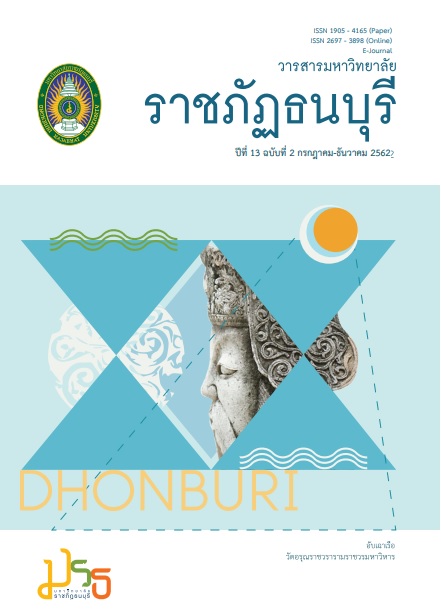การวิเคราะห์สีในงานจิตรกรรมลัทธิอิมเพรสชั่นนิสม์ และการสร้างสรรค์ภาพที่ส่งเสริมอารมณ์ด้านบวก
คำสำคัญ:
อารมณ์ทางบวก, ภาพศิลปะอิมเพรสชั่นนิสม, ทัศนธาตุทางศิลปะด้านสีบทคัดย่อ
การวิจัยนี้มีวัตถุประสงค์เพื่อ 1) วิเคราะห์ทัศนธาตุทางศิลปะด้านสีของภาพลัทธิอิมเพรสชั่นนิสม์ 2)สร้างสรรค์ภาพใหม่โดยนำผลจากการวิเคราะห์ทัศนธาตุทางศิลปะด้านสีมาใช้และ3)ศึกษาประสิทธิผลของภาพที่สร้างสรรค์ โดยประเมินการรับรู้ทางอารมณ์และวิเคราะห์คลื่นไฟฟ้าสมองขณะดูภาพ อาสาสมัครเข้าร่วมการทดลองมีอายุระหว่าง 18-22 ปีเพศชายและหญิง จำนวน 43 คน เครื่องมือที่ใช้ในการวิจัยประกอบด้วย ภาพที่ใช้ส่งเสริมอารมณ์ด้านบวก แบบประเมินอารมณ์ (Emotion Rating Scale) ผลการวิจัยปรากฏว่า ภาพที่นำมาใช้ในงานวิจัยนี้มีความสอดคล้องกับอารมณ์ความสุขมากที่สุด รองลงมาคืออารมณ์ความหวังและอารมณ์ความรัก ตามลำดับ การสร้างสรรค์ภาพที่สามารถทำให้ผู้ชมเกิดอารมณ์ความสุขประกอบด้วยความสำคัญกับพื้นที่ ความสมบูรณ์และความลงตัวขององค์ประกอบ และการใช้สีที่มีค่ามุมเฉดสีอยู่ระหว่าง76-146องศาและค่าความสว่างของสีอยู่ระหว่าง21-80 ภาพที่สอดคล้องกับอารมณ์ความหวัง ประกอบด้วยพื้นที่ว่าง มีทิศทางการเคลื่อนไหวระหว่างพื้นที่ว่างกับรูปทรงอย่างต่อเนื่องและประกอบด้วยสีที่มีค่ามุมเฉดสีอยู่ระหว่าง 0-49 องศา และค่าความสว่างของสีอยู่ระหว่าง 21-80 และภาพที่สอดคล้องกับอารมณ์ความรักสะท้อนให้เห็นถึงการมีปฏิสัมพันธ์ระหว่างกันของพื้นที่ว่าง ระยะทาง ทิศทางการเคลื่อนไหว รูปทรงของวัสดุและรูปทรงมนุษย์และประกอบด้วยสีที่มีค่ามุมเฉดสีอยู่ระหว่าง 0-41 และ 76-119 องศา และค่าความสว่างของสีอยู่ระหว่าง21-80จากการศึกษาประสิทธิผลของภาพที่สร้างสรรค์ด้วยการประเมินการรับรู้ทางอารมณ์คะแนนเฉลี่ย (M) ของอารมณ์ที่ได้จากการดูภาพที่ส่งเสริมอารมณ์ความสุข ความหวัง และความรัก โดยมีค่าเฉลี่ยเท่ากับ 4.31, 4.08และ 3.50คะแนน และค่าส่วนเบี่ยงเบนมาตรฐาน (S.D.) เท่ากับ 0.78, 0.90และ0.80 คะแนน ตามลำดับ และวิเคราะห์คลื่นไฟฟ้าสมองของอารมณ์ด้านบวกทั้งสามด้าน (ความรัก ความสุขและความหวัง) พบว่าค่าเฉลี่ยคลื่นไฟฟ้าสัมบูรณ์ของสมองย่านอัลฟ่า ณ สมองส่วนหน้าฝั่งซ้ายมีค่าใกล้เคียงกันอยู่ระหว่าง 0.023-0.024 และค่าเฉลี่ยคลื่นไฟฟ้าสัมบูรณ์ของสมองย่านอัลฟ่า ณ สมองส่วนหน้าฝั่งขวามีค่าเท่ากับ 0.013, 0.017 และ 0.016 ตามลำดับ
Downloads
เอกสารอ้างอิง
Indian Psychology. 3 (2), pp. 14-18.
Belkofer, C.M., & Konopka, L.M. (2008). Conducting art therapy research using quantitative
EEG measures. Art Therapy. 25 (2), pp. 56-63.
Coan, J.A., Allen, J. J.B., & Harmon-Jones,E. (2001).Voluntaryfacialexpressionand hemispheric
asymmetry over the frontal cortex. Psychophysiology. 38 (6), pp. 912-925.
Cuthbert,B.N.,Schupp, H.T.,Bradley, M.M.,Birbaumer, N., & Lang,P. J. (2000).Brain potentials
in affective picture processing : Covariation with autonomic arousal and affective
report. Bio-logical Psychology. 52, pp. 95-111.
Dalebroux, A., Goldstein, T., & Winner, E. (2008). Short-term mood repair through
artmaking:Positiveemotionismoreeffectivethanventing. Motivation and Emotion.
32 (4), pp. 288–295.
Diener, E., & Emmons, R.A. (1984). The independence of positive and negative affect.
Journal of Personality and Social Psychology. 47 (5), pp. 1105-1117.
Egloff, B. (1998). The independence of positive and negative affect depends on the affect
measure. Personality and Individual Differences. 25 (6), pp. 1101-1109.
Ekman, P., & Davidson, R.J. (1993). Voluntary Smiling Changes Regional Brain Activity.
Psychological Science. 4 (5), pp. 342-345.
Foti, D., & Hajcak, G. (2008). Deconstructing reappraisal : Descriptions preceding arousing
pictures modulate the subsequent neural response. Journal of Cognitive
Neuroscience. 20 (6), pp. 977–988.
Hajcak, G., & Olvet, D.M. (2008). The persistence of attention to emotion : brain potentials
during and after picture presentation. Emotion. 8 (2), pp. 250-255.
Hu, X., Yu, J., Song, M., Yu, C., Wang, F., Sun, P., Wang, D., & Zhang, D. (2017). EEG correlates
of ten positive emotions. Frontiers in Human Neuroscience. 11, p. 26.
Kan, D.P.X., & Lee, P.F. (2015, May). Decrease alpha waves in depression :
An electroencephalogram (EEG) study. Retrieved August 11, 2019, from https://
www.semanticscholar.org.
Lankston, L., Cusack, P., Fremantle, C., & Isles, C. (2010). Visual art in hospitals : case studies
and review of the evidence. Journal of the Royal Society of Medicine. 103 (12),
pp. 490–499.
Mars,W. (2014). The Martian Color wheel.Retrieved, fromhttp ://warrenmars.com/visual_art/
theory/colour_wheel/colour_wheel.htm
Nanda, U. (2011). It’s All About Healing. Health Environment Research & Design Journal.
4 (3), pp. 3-6.
Shizu, T., & Zeki, S. (2011) Toward A Brain-Based Theory of Beauty. Retrieved August 11,
2019, from https://doi.org/10.1371/journal.pone.0021852.
Sieger, T., Serranová, T., Ružička, F., Vostatek, P., Wild, J., Štastná, D., Bonnet, C., Novák,
D., Ružička, E., Urgošík, D., & Jech, R. (2015). Distinct populations of neurons respond
toemotionalvalenceand arousal inthehumansubthalamicnucleus.Proceedings of
the National Academy of Sciences. 112 (10), pp. 3116-3121.
Tan, E.S. (2000). Emotion, art and the humanities. In Lewis M. & Haviland – Jones J.M., (Eds.),
Handbook of emotions. 2nd ed. New York : Guilford Press.
Timmons, A., & MacDonald, E. (2008). Alchemy and magic : the experience of using clay
for people withchronicillnessand disability. British Journal of Occupational Therapy.
71 (3), pp. 86-94.
ดาวน์โหลด
รูปแบบการอ้างอิง
ฉบับ
ประเภทบทความ
สัญญาอนุญาต
ลิขสิทธิ์ (c) 2021 มหาวิทยาลัยราชภัฏธนบุรี

อนุญาตภายใต้เงื่อนไข Creative Commons Attribution-NonCommercial-NoDerivatives 4.0 International License.
บทความที่ได้รับการตีพิมพ์เป็นลิขสิทธิ์ของมหาวิทยาลัยราชภัฏธนบุรี
ข้อความที่ปรากฏในบทความแต่ละเรื่องในวารสารวิชาการเล่มนี้เป็นความคิดเห็นส่วนตัวของผู้เขียนแต่ละท่านไม่เกี่ยวข้องกับมหาวิทยาลัยราชภัฏธนบุรีและบุคลากรท่านอื่น ๆ ในมหาวิทยาลัยฯ แต่อย่างใด ความรับผิดชอบองค์ประกอบทั้งหมดของบทความแต่ละเรื่องเป็นของผู้เขียนแต่ละท่าน หากมีความผิดพลาดใด ๆ ผู้เขียนแต่ละท่านจะรับผิดชอบบทความของตนเองแต่ผู้เดียว







